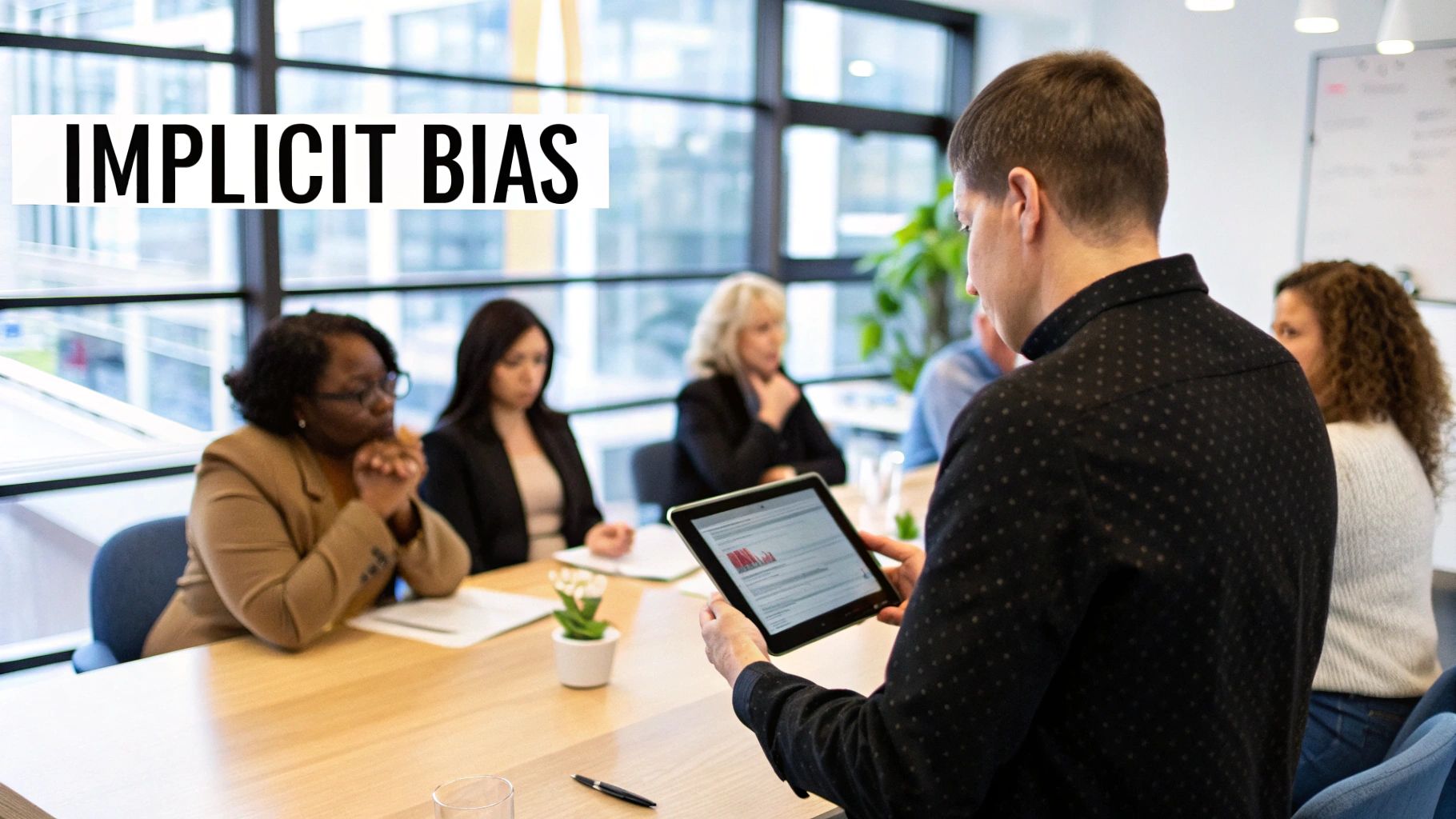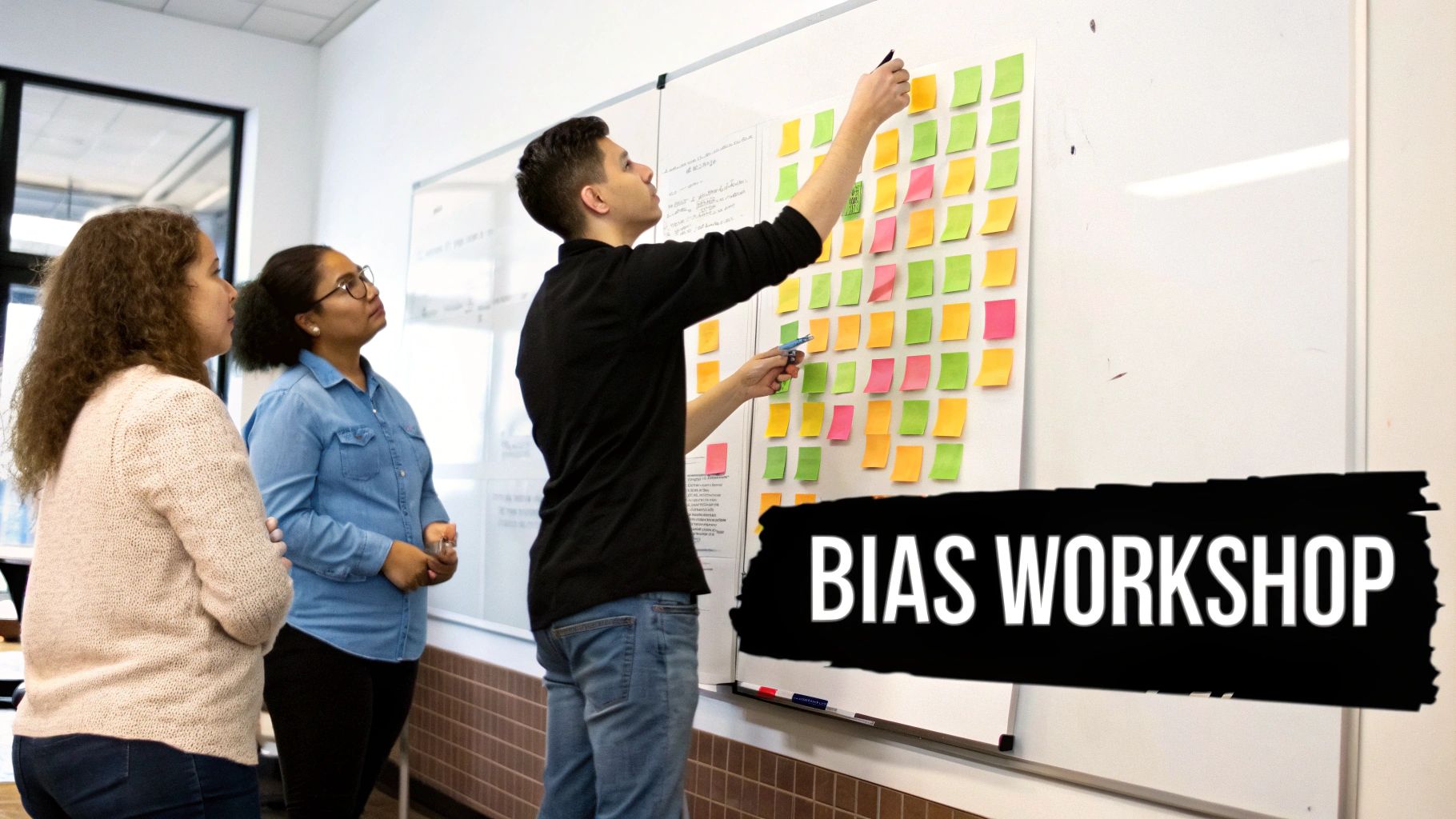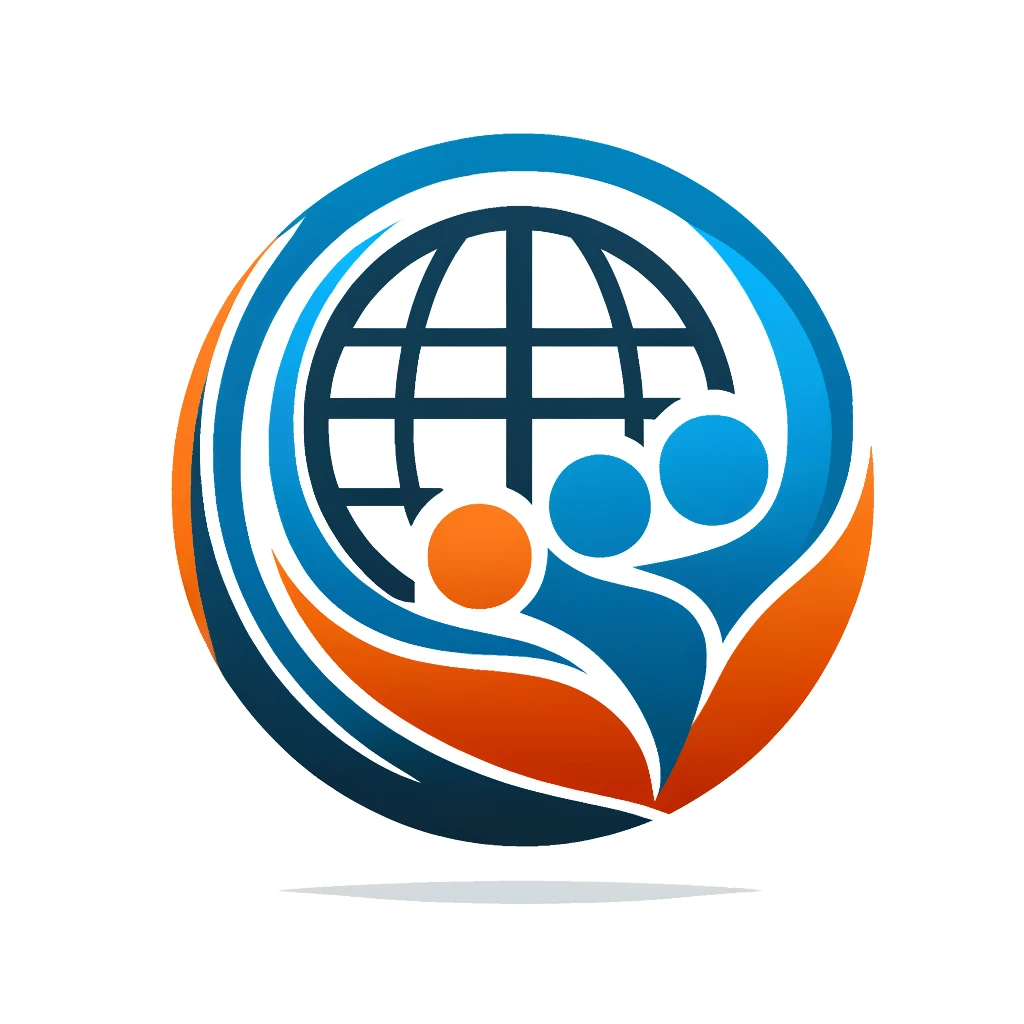Building a Better Workplace Through Diversity and Inclusion Training
Want to build a more equitable and successful workplace? This listicle showcases seven exceptional diversity and inclusion training programs that can help. Learn how programs from industry leaders like Google, Microsoft, and PwC are fostering inclusive cultures and driving positive change. Discover practical strategies and insights to implement effective diversity and inclusion training programs within your own organization. These programs equip your workforce with the skills to promote respect, understanding, and collaboration, ultimately benefiting your organization's performance and employer brand.
1. PwC's Unconscious Bias Training Program
Creating a truly inclusive workplace requires addressing the hidden biases that can unknowingly influence our decisions and interactions. PwC's Unconscious Bias Training Program stands out as a leading solution for organizations committed to fostering diversity and inclusion. This comprehensive program tackles implicit biases head-on, empowering individuals to recognize their own biases and develop strategies for mitigation. It leverages evidence-based approaches to drive meaningful change, ultimately creating a more equitable and welcoming environment for everyone.

PwC's program goes beyond simple awareness training. It provides a deep dive into the science of cognitive biases, exploring how these unconscious shortcuts in our thinking can affect hiring, promotion, performance reviews, and everyday interactions. Through interactive workshops, engaging digital learning modules, and ongoing reinforcement activities, participants gain practical skills to identify, challenge, and mitigate their biases. The program's blended learning approach caters to diverse learning styles and ensures sustained engagement. Further strengthening its impact are custom scenarios tailored to specific industries and roles, allowing participants to apply their learning directly to their work context. Built-in measurement tools provide valuable data to track progress and demonstrate the program's effectiveness in reducing bias over time. Importantly, PwC's Unconscious Bias Training Program is designed to integrate seamlessly with broader organizational diversity, equity, and inclusion (DEI) initiatives, ensuring a holistic and sustainable approach to culture change.
This program’s impressive track record speaks for itself. Fortune 500 companies like Microsoft and Coca-Cola have witnessed remarkable results after implementing PwC’s training. Microsoft reported a 20% increase in inclusive behaviors as measured by employee surveys, while Coca-Cola saw a 35% reduction in hiring disparities. These examples highlight the transformative potential of this program when implemented effectively.
Features and Benefits:
- Science-backed curriculum: Grounded in the latest research on cognitive biases.
- Blended learning: Combines in-person workshops and digital modules for flexibility and engagement.
- Customizable content: Tailored scenarios relevant to specific industries and roles.
- Measurable results: Tools to track bias reduction and demonstrate ROI.
- Integration with broader DEI initiatives: Supports a holistic approach to culture change.
Pros:
- Proven track record with leading organizations.
- Focuses on practical, actionable bias mitigation strategies.
- Customizable to address specific organizational challenges.
- Includes follow-up reinforcement to maintain behavior change.
Cons:
- Can require a significant investment for full organizational implementation.
- Requires leadership buy-in for maximum effectiveness.
- Achieves optimal results when paired with broader systemic changes.
Tips for Successful Implementation:
- Start at the top: Begin with executive leadership training to model inclusive behaviors throughout the organization.
- Align with HR processes: Pair training with updates to HR policies and procedures for reinforcement.
- Measure impact: Collect baseline data before implementation to effectively track progress.
- Reinforce learning: Schedule regular refresher sessions to maintain long-term behavior change.
Why PwC's Unconscious Bias Training Deserves Its Place on the List: This program stands out due to its comprehensive approach, proven track record, and focus on actionable strategies. It empowers individuals to become active agents of change, creating a more inclusive and equitable workplace. For organizations seeking a robust and impactful diversity and inclusion training program, PwC's offering is a powerful solution. While a direct link to the program isn't readily available (general PwC HR Transformation link provided as a starting point), contacting PwC directly can provide further details and tailored solutions. This program truly exemplifies how targeted training can be a catalyst for creating a workplace where everyone feels valued, respected, and empowered to thrive.
2. Google's Re:Work Unconscious Bias Workshop
Looking for a powerful, research-backed, and accessible diversity and inclusion training program? Google's Re:Work Unconscious Bias Workshop may be the perfect solution. This program, developed and implemented within Google, has become a leading resource for organizations worldwide seeking to understand and address unconscious bias in the workplace. It offers a comprehensive approach that combines cutting-edge research with practical exercises, providing a foundational understanding of how unconscious biases influence decisions and offering tangible strategies for mitigation. This workshop empowers individuals to recognize their own biases and create a more inclusive work environment.

The workshop's strength lies in its data-driven approach, grounded in behavioral science research. Through interactive exercises simulating real workplace scenarios, participants gain a practical understanding of how unconscious biases manifest in hiring, performance reviews, promotions, and everyday interactions. This experiential learning allows for deeper engagement and a more impactful understanding of the subject matter. What makes this program truly unique is its open-source nature. Google has generously made all workshop materials freely available, making it accessible to organizations of all sizes, regardless of budget constraints. The scalable framework also allows for adaptation and customization to fit different organizational contexts and industries.
This workshop deserves its place on this list due to its proven effectiveness and accessibility. At Google, implementation of this workshop led to measurable improvements in hiring diversity, demonstrating its potential to create real change. Furthermore, its adoption by numerous tech startups and educational institutions speaks to its broad applicability and impact.
Features and Benefits:
- Open-source materials: Free and readily available for any organization to adapt and use.
- Data-driven approach: Based on robust behavioral science research, ensuring a credible and effective learning experience.
- Interactive exercises: Engaging scenarios that simulate real-world situations, promoting deeper understanding and application.
- Scalable framework: Adaptable for organizations of different sizes and across various industries.
- Integration with management and hiring practices: Offers tools and strategies for embedding bias mitigation into core organizational processes.
Pros:
- Documented positive impact: Proven to improve diversity metrics at Google.
- Accessibility: Free materials make it a budget-friendly option for any organization.
- Continuously updated: Reflects the latest research and best practices in unconscious bias mitigation.
- Cross-cultural applicability: Designed to be relevant and effective in diverse international contexts.
Cons:
- Customization required: Generic materials may need tailoring to fit specific industry nuances.
- Self-implementation challenges: May lack the impact of professionally facilitated sessions.
- Focus on awareness: Primarily addresses awareness rather than systemic change, requiring further initiatives for broader impact.
Examples of Successful Implementation:
- Google: Measurable improvements in hiring diversity following program implementation.
- Tech startups: Widely adopted by startups seeking to emulate Google's diversity and inclusion efforts.
- Educational institutions: Utilized to train faculty and staff on unconscious bias in academic settings.
Actionable Tips for Implementation:
- Customize scenarios: Adapt the provided scenarios to reflect the specific challenges and contexts within your industry.
- Set concrete goals: Define measurable diversity outcomes to track progress and hold stakeholders accountable.
- Integrate into broader DEI initiatives: Use the workshop as a foundation for more comprehensive diversity, equity, and inclusion strategies.
- Create accountability mechanisms: Establish systems for tracking behavioral changes and reinforcing learned concepts.
When and Why to Use This Approach:
This workshop is ideal for organizations seeking a cost-effective, research-based approach to unconscious bias training. It's particularly useful as a foundational program to raise awareness and equip individuals with practical tools for mitigating bias in everyday decisions. While it serves as an excellent starting point, remember to combine it with other DEI initiatives to address systemic issues and foster lasting change. You can access the resources for the Re:Work Unconscious Bias Workshop at rework.withgoogle.com (Please note the correct URL is rework.withgoogle.com. The provided image URL was for the infographic).
Popularized by: Google, Laszlo Bock (former SVP of People Operations at Google), Brian Welle (Google's Director of People Analytics)
3. Paradigm IQ Diversity and Inclusion Training
Looking for diversity and inclusion training programs that create real, lasting change within your organization? Paradigm IQ offers an evidence-based approach that goes beyond surface-level awareness and dives deep into the cognitive science and social psychology behind bias. Their programs are designed to foster sustainable behavior change, both at the individual and organizational level, leading to truly inclusive workplaces where everyone can thrive. This isn't just a checkbox exercise; it's a commitment to building a better future for your company and your employees.

Paradigm IQ's methodology centers around understanding how our brains work and how that influences our interactions in the workplace. By addressing unconscious biases and systemic barriers, they equip individuals with the tools and strategies to create a more equitable environment. This approach resonates deeply because it acknowledges the complexity of human behavior and provides practical solutions for navigating difficult conversations and fostering empathy.
Their research-backed training modules tackle specific types of bias, and the programs can be customized to fit specific industry needs and organizational roles, from executives to individual contributors. Whether you need online or in-person delivery, Paradigm IQ offers flexibility to meet your organization's unique requirements. A robust measurement framework allows you to evaluate the impact of the training and demonstrate tangible results.
Examples of Paradigm IQ's Success:
- Airbnb: Partnered with Paradigm IQ to strengthen their comprehensive approach to fighting discrimination within their platform and internal operations.
- Pinterest: Collaborated with Paradigm IQ to create inclusive hiring practices, resulting in a significant increase in the hiring of underrepresented talent.
- Slack: Integrated Paradigm IQ training as part of their diversity initiatives, contributing to improved retention rates for underrepresented employees.
These success stories demonstrate the power of Paradigm IQ's approach and highlight its potential to transform workplace culture. It's a testament to the program's efficacy in driving positive change and fostering more inclusive environments.
Pros:
- Developed by diversity researchers and behavioral scientists
- Focuses on practical behavioral changes, not just awareness
- Provides actionable strategies tailored to specific workplace contexts
- Includes pre- and post-training assessment tools
Cons:
- Higher price point than some alternative programs
- Requires long-term engagement for optimal effectiveness; one-off sessions are less impactful
- Necessitates organizational commitment to systemic change
Tips for Maximizing Impact:
- Begin with an organizational assessment to identify specific diversity and inclusion challenges.
- Prioritize training managers before individual contributors to create a cascading effect.
- Establish clear metrics to track progress and demonstrate the return on investment.
- Combine training with a review of existing policies and procedures to ensure alignment.
When and Why to Use Paradigm IQ:
Paradigm IQ is the ideal choice for organizations committed to fostering genuine, lasting change. If you're ready to move beyond surface-level diversity and inclusion initiatives and invest in a program that addresses systemic issues and empowers your employees to create a more inclusive workplace, Paradigm IQ is the right partner for you. This approach deserves its place on this list because it offers a scientifically grounded, practical, and impactful solution to creating truly equitable and inclusive organizations. It's not just about training; it's about transformation.
While the price point might be higher than some alternatives, the long-term benefits of creating a truly inclusive and equitable workplace far outweigh the initial investment. This commitment to impactful change is what sets Paradigm IQ apart. For more information, visit Paradigm's website. (Please note that the actual URL may have changed since this response was generated.)
4. Microsoft's Inclusive Hiring Training Program
Building a truly diverse and inclusive workforce starts with how you hire. Microsoft's Inclusive Hiring Training Program provides a powerful framework for organizations seeking to eliminate bias and build a more representative team. This comprehensive program tackles unconscious bias head-on, empowering hiring managers and recruiters to recognize and mitigate biases that can unfairly impact candidate evaluation. It emphasizes structured processes to promote equitable talent acquisition, creating a level playing field for all applicants. This approach moves beyond simply acknowledging diversity and inclusion; it provides actionable strategies for creating real change within your organization.

Microsoft's program stands out for its targeted approach, featuring specialized training modules tailored to different hiring stages, from sourcing and interviewing to the final selection. This granular focus ensures that bias is addressed at every step. The program also champions the use of structured interview frameworks and scorecards, enabling more objective and consistent evaluations of candidates. Practical tools for crafting inclusive job descriptions, coupled with diverse slate requirements and meticulous tracking metrics, further solidify the program's commitment to building diverse teams. The program's integration with Microsoft's broader inclusion ecosystem underscores the company's commitment to holistic diversity and inclusion efforts.
Features and Benefits:
- Specialized Training Modules: Targeted training for each stage of the hiring process.
- Structured Interview Frameworks: Promotes consistent and objective candidate assessment.
- Inclusive Job Description Tools: Helps attract a diverse pool of qualified applicants.
- Diverse Slate Requirements: Ensures a diverse range of candidates are considered.
- Tracking Metrics: Provides data-driven insights into progress and areas for improvement.
Pros:
- Directly addresses pipeline issues impacting workforce diversity.
- Delivers measurable results in diverse candidate hiring.
- Focuses on driving behavioral changes in hiring managers.
- Leverages technology to minimize bias.
Cons:
- Primarily focused on hiring, not broader inclusion issues.
- Requires significant adjustments to existing hiring processes.
- Maximum effectiveness achieved when integrated with other inclusion initiatives.
Examples of Successful Implementation:
- Implemented globally across Microsoft, leading to increased diversity in technical roles.
- Adopted by LinkedIn (a Microsoft subsidiary) to enhance their talent acquisition process.
- Shared with Microsoft partners as a part of industry best-practice initiatives.
Actionable Tips for Implementation:
- Data Analysis: Begin by analyzing current hiring patterns to pinpoint specific biases.
- Comprehensive Training: Train all stakeholders involved in hiring, not just decision-makers.
- Structured Interviews: Employ structured interviews with standardized evaluation criteria.
- Diversity Goals: Set specific diversity goals for candidate pools and track progress diligently.
When and Why to Use This Approach:
This program is ideal for organizations committed to building a truly diverse workforce and willing to invest in overhauling their hiring processes. It offers a data-driven, structured approach that delivers tangible results. Microsoft's Inclusive Hiring Training Program deserves its place on this list because it provides a concrete example of how a major corporation successfully implemented diversity and inclusion training programs, and because it offers a blueprint for others to follow. By embracing this program, organizations can move beyond aspirational goals and towards a more equitable and inclusive future. This program resonates particularly well with aspiring HR professionals, experienced HR specialists, educational institutions, corporate HR teams, and the global HR community, equipping them with the tools and knowledge to build diverse and inclusive teams. Inspired by the leadership of Satya Nadella (Microsoft CEO) and Lindsay-Rae McIntyre (Microsoft Chief Diversity Officer), this program sets a powerful example for organizations striving for genuine change in their diversity and inclusion initiatives.
5. Cook Ross Unconscious Bias Training
For organizations truly committed to fostering diversity and inclusion, Cook Ross Unconscious Bias Training stands as a gold standard among diversity and inclusion training programs. Pioneered by Howard Ross, a recognized thought leader in the field, and bolstered by collaborations with influential figures like Dr. Johnnetta B. Cole, this program offers a deeply impactful approach that goes beyond surface-level awareness and drives lasting change. Cook Ross leverages decades of research and practical experience to deliver a program that is both scientifically rigorous and organizationally relevant.
Understanding the Approach:
Cook Ross's methodology acknowledges that unconscious biases are ingrained patterns of thinking that can inadvertently influence our perceptions, decisions, and interactions. The program works by first illuminating these hidden biases, helping individuals become aware of how they might be impacting their workplace behavior. It then equips participants with the skills and strategies to mitigate these biases and foster a more inclusive environment. Crucially, Cook Ross doesn't stop at individual awareness; it also tackles systemic change, integrating inclusive practices into organizational systems and processes.
Features and Benefits:
Cook Ross offers a highly personalized experience. Before any program design, they conduct a customized needs assessment to ensure the training aligns perfectly with the organization's unique culture and challenges. This tailored approach is reflected in the multiple delivery formats available, ranging from engaging keynotes and interactive workshops to flexible e-learning modules. To ensure lasting impact, Cook Ross provides advanced facilitator training for internal champions, empowering organizations to sustain the momentum of inclusion long after the formal training concludes. They also offer ongoing reinforcement tools and resources, further solidifying the learning and embedding inclusive practices within the organizational DNA.
Pros:
- Pioneering Expertise: Benefit from decades of experience and a proven track record of successful implementation.
- Tailored Solutions: Highly customized programs address specific organizational needs and cultural nuances.
- Holistic Approach: Focuses on both individual awareness and systemic change for sustainable impact.
- Measurable Results: Rigorous assessment methodology tracks progress and demonstrates the training's effectiveness.
Cons:
- Premium Investment: The depth and customization of the program come with a higher price tag.
- Time Commitment: Full implementation requires a significant investment of time and resources.
- Long-Term Value: The program's value is maximized with a multi-year commitment to sustain the changes.
Examples of Success:
The impact of Cook Ross's training is evident in its impressive roster of clients. Coca-Cola integrated the program into their diversity transformation initiative, numerous healthcare organizations have utilized it to address disparities in patient care, and even federal agencies have adopted it for government-wide bias mitigation efforts.
Actionable Tips for Implementation:
- Thorough Assessment: Conduct a comprehensive organizational assessment to pinpoint specific areas for improvement.
- Internal Champions: Identify and train internal champions to maintain momentum and drive ongoing inclusion efforts.
- Process Integration: Link bias awareness training to specific business processes and decision-making frameworks.
- Metrics-Driven Approach: Develop clear metrics to track the training's impact on key diversity indicators.
When and Why to Choose Cook Ross:
Cook Ross Unconscious Bias Training is ideal for organizations seeking a transformative approach to diversity and inclusion. If your organization is ready to move beyond superficial gestures and commit to deep, systemic change, this program offers a powerful pathway to creating a truly inclusive workplace. While it requires a significant investment of time and resources, the potential for long-term, positive change makes Cook Ross a worthwhile consideration for any organization striving for genuine diversity and inclusion. This program's comprehensive methodology, customization, and focus on both individual and systemic change secure its well-deserved place on this list of impactful diversity and inclusion training programs. Contact Cook Ross directly for more information and pricing. This information is designed to inspire action and provides specific insights for aspiring HR professionals, experienced HR specialists, educational institutions, corporate HR teams, and the global HR community, empowering them to cultivate inclusive excellence within their organizations.
6. LinkedIn Learning Diversity, Inclusion, and Belonging Suite
Cultivating a truly diverse, inclusive, and belonging (DIBs) workplace requires ongoing learning and development. For organizations seeking a scalable and impactful solution, the LinkedIn Learning Diversity, Inclusion, and Belonging Suite offers a powerful platform to empower employees with the knowledge and skills to foster positive change. This comprehensive suite earns its place on our list due to its accessibility, breadth of content, and proven effectiveness in fostering more inclusive work environments.
This dynamic program leverages LinkedIn Learning's extensive online platform to deliver a library of 50+ courses covering a wide spectrum of DIBs topics. From understanding unconscious bias and microaggressions to practicing inclusive leadership and allyship, the suite provides on-demand access to expert-led content, interactive exercises, and assessments, all designed to deepen understanding and drive behavioral change. This digital format allows employees to learn at their own pace, anytime, anywhere, ensuring consistent training quality across even the most distributed workforces.
What makes the LinkedIn Learning DIBs Suite stand out?
- Scalability and Cost-Effectiveness: Ideal for organizations of all sizes, this solution eliminates the logistical and financial hurdles often associated with in-person training, making high-quality DIBs education accessible to everyone. Companies like Target, with its 350,000+ employees, have successfully implemented this program, demonstrating its scalability and achieving impressive completion rates. Smaller businesses, often lacking dedicated DEI resources, also find this a valuable and affordable option.
- Rich and Engaging Content: Developed by recognized diversity practitioners like Dr. Shirley Davis, the curriculum is regularly updated with the latest research and best practices, ensuring relevance and impact. Interactive exercises and assessments reinforce learning and provide opportunities for self-reflection.
- Integration with LinkedIn Learning Ecosystem: Seamlessly integrated with LinkedIn Learning's broader professional development platform, the DIBs suite complements existing training programs and reinforces a culture of continuous learning. Trackable completion and engagement metrics provide valuable data to monitor progress and demonstrate ROI.
Pros:
- Highly scalable for organizations of all sizes
- Cost-effective compared to in-person facilitation
- Allows employees to learn at their own pace
- Regularly updated with new content and research
- Trackable completion and engagement metrics
Cons:
- Less personalized than facilitated workshops
- Limited opportunity for group discussion and processing
- Varying levels of engagement without accountability structures
- May not address organization-specific challenges without supplementation
Actionable Tips for Maximizing Impact:
- Curated Learning Paths: Create specific course sequences tailored to different roles and responsibilities within your organization.
- Foster Dialogue and Reflection: Supplement online learning with facilitated discussion groups or workshops to encourage deeper processing of the content and peer-to-peer learning.
- Establish Clear Expectations: Set deadlines and communicate the importance of completing assigned courses to drive engagement and accountability.
- Customize and Expand: Use the LinkedIn Learning content as a foundation for developing more customized in-person workshops that address specific organizational challenges and foster a sense of community.
When and Why to Use This Approach:
The LinkedIn Learning DIBs Suite is an excellent choice for organizations seeking a foundational and scalable approach to diversity and inclusion training. It's particularly beneficial for:
- Organizations with distributed workforces
- Companies seeking a cost-effective solution
- Businesses looking to establish a baseline level of DIBs knowledge and awareness
- Teams wanting to supplement existing in-person training programs
By leveraging the power of online learning, the LinkedIn Learning Diversity, Inclusion, and Belonging Suite empowers organizations to embark on a journey of continuous improvement, fostering a workplace where every individual feels valued, respected, and empowered to contribute their unique talents. Link to LinkedIn Learning
7. Culture Amp's Diversity and Inclusion Survey and Training Program
Creating a truly inclusive workplace requires more than just good intentions; it demands a data-driven approach. Culture Amp's Diversity and Inclusion Survey and Training Program offers a powerful solution, empowering organizations to move beyond generic training and tackle the specific inclusion challenges they face. This integrated platform combines cutting-edge survey technology with targeted training interventions, enabling you to measure, understand, and ultimately transform your workplace culture. This data-driven approach makes it a standout choice among diversity and inclusion training programs, ensuring your efforts are focused and effective.
How it Works:
Culture Amp's approach is built on a foundation of data. It begins with scientifically validated inclusion survey instruments that benchmark your organization against industry standards and best practices. This initial assessment pinpoints your unique areas for improvement, allowing you to move away from guesswork and towards targeted action. The platform then provides access to focused training modules designed to address the specific gaps identified in your survey results. This integrated system ensures that learning is directly linked to measurement, maximizing impact and demonstrating a clear return on investment (ROI). Ongoing pulse surveys track progress over time, allowing for continuous improvement and adaptation.
Examples of Success:
Culture Amp has empowered numerous organizations to cultivate more inclusive environments. Airbnb leveraged the platform to identify and address inclusion gaps across its global offices, ensuring a consistent experience for all employees. REI used Culture Amp to measure and improve inclusion across both retail and corporate environments, demonstrating the program’s versatility. Even Pixar, a company known for its creative culture, adopted Culture Amp to foster a more inclusive environment for its diverse talent.
Actionable Tips for Implementation:
- Start with a Baseline: Before implementing any training, conduct a baseline measurement using Culture Amp’s survey tools to understand your current state.
- Focus on Key Gaps: Concentrate your training resources on the areas where the survey reveals the largest discrepancies between your current state and desired outcomes.
- Develop Action Plans: Create function-specific action plans based on the survey results. This will ensure that every team has a clear path forward.
- Track Progress with Pulse Surveys: Conduct regular pulse surveys, ideally quarterly, to monitor progress and adjust your approach as needed. This allows you to stay agile and responsive to the evolving needs of your organization.
When and Why to Use This Approach:
Culture Amp's program is particularly valuable for organizations with at least 100 employees, as this allows for robust data analysis and benchmarking. It's ideal for organizations committed to a data-driven approach to diversity and inclusion, seeking measurable results, and aiming to move beyond generic, one-size-fits-all training programs. If you're ready to invest in a truly transformative approach to D&I, Culture Amp can be a game-changer.
Pros:
- Data-driven approach ensures training addresses actual needs.
- Enables precise ROI measurement for D&I initiatives.
- Combines assessment and intervention in one integrated system.
- Allows for targeted approach rather than generic training.
Cons:
- Technology focus may feel impersonal compared to high-touch approaches.
- Requires strong internal champions to drive action from insights.
- Most valuable for organizations with at least 100+ employees.
Popularized By: Culture Amp, Didier Elzinga (CEO and Co-founder), Jennifer Kim (startup diversity advocate and Culture Amp collaborator)
This program deserves its place on this list because it empowers organizations to take a strategic, evidence-based approach to diversity and inclusion. By combining robust measurement with targeted training, Culture Amp helps create workplaces where everyone feels valued, respected, and empowered to contribute their best. This translates into a more engaged workforce, improved innovation, and ultimately, a stronger bottom line.
Diversity & Inclusion Training Program Comparison
| Training Program | Implementation Complexity 🔄 | Resource Requirements 💡 | Expected Outcomes 📊 | Ideal Use Cases 💡 | Key Advantages ⭐ |
|---|---|---|---|---|---|
| PwC's Unconscious Bias Training Program | High – blended delivery, ongoing reinforcement | Significant investment, leadership buy-in needed | Measurable bias reduction, improved inclusive behaviors | Large organizations seeking systemic DEI integration | Customizable, practical strategies, proven Fortune 500 success |
| Google's Re:Work Unconscious Bias Workshop | Moderate – open-source, scalable frameworks | Low to moderate; free materials available | Increased awareness and hiring diversity improvements | Organizations with limited budgets, early DEI adopters | Free, updated constantly, culturally adaptable |
| Paradigm IQ Diversity and Inclusion Training | High – role-specific, long-term engagement preferred | Higher price point, organizational commitment | Sustainable behavior change, improved inclusion metrics | Organizations seeking systemic and individual change | Research-backed, role-specific, actionable strategies |
| Microsoft's Inclusive Hiring Training Program | Moderate to high – structured hiring stage modules | Significant process changes and training needed | Measurable increases in diverse hiring | Companies targeting hiring process bias reduction | Focused on hiring pipeline, structured tools, measurable |
| Cook Ross Unconscious Bias Training | High – highly customized, multi-year commitment | Premium pricing, time-intensive | Deep individual and systemic change with rigorous impact tracking | Organizations wanting comprehensive long-term change | Pioneer with rigorous assessments, extensive customization |
| LinkedIn Learning Diversity, Inclusion Suite | Low – on-demand digital courses | Cost-effective, scalable | Consistent DEI foundational knowledge across workforce | Organizations needing scalable, accessible training | Scalable, flexible, expert-led, trackable completion rates |
| Culture Amp Diversity and Inclusion Program | Moderate to high – integration of survey and training | Requires internal champions, technology investment | Data-driven targeted improvements, precise ROI measurement | Medium to large companies focused on measurement | Combines measurement & training, targeted interventions |
The Future of Diversity and Inclusion: Continuous Learning and Growth
Diversity and inclusion training programs, such as those offered by PwC, Google, Paradigm IQ, Microsoft, Cook Ross, LinkedIn Learning, and Culture Amp, are more than just workplace initiatives; they are essential investments in building a better future for organizations. This article has highlighted some of the leading programs available, showcasing the variety of approaches and resources at your disposal. The key takeaway is that fostering true inclusion requires a commitment to continuous learning, adaptation, and improvement. These programs provide the foundational knowledge and practical skills needed to create environments where every individual feels valued, respected, and empowered to contribute their unique talents. Building diverse and inclusive teams is crucial for creating a positive and productive work environment. To further explore the key elements that contribute to successful teamwork, consider this resource on what makes a good team from Kirke Leadership.
Mastering the concepts and approaches presented in these diversity and inclusion training programs unlocks immense value, driving not only positive cultural shifts but also tangible business benefits. Increased creativity, improved problem-solving, enhanced employee engagement, and a stronger brand reputation are just a few of the rewards of a truly inclusive workplace. This journey requires ongoing dedication, and resources like those offered by the Global Human Resource Institute can be invaluable in developing the expertise needed to cultivate lasting change.
Embrace the opportunity to build a more equitable and thriving future for your organization and for the world. Start by deepening your understanding of diversity and inclusion best practices and commit to continuous growth in this vital area. Ready to take the next step in building a more inclusive workplace? Explore the resources and certification programs offered by the Global Human Resource Institute and empower yourself to become a leader in diversity and inclusion.




0 Comments